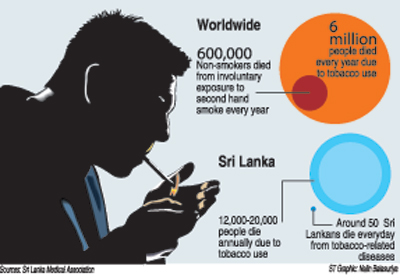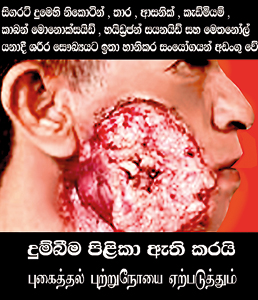News
Shun/quit smoking, says medical fraternity in unison
The medical fraternity threw its full force behind the Government on Tuesday, reiterating in one voice that “smoking kills” and there is a need to alert people to the deadly risks through pictorial warnings on the packets of cigarettes.
“People should quit smoking. There is no other alternative,” underscored Sri Lanka Medical Association (SLMA) President Prof. Vajira H.W. Dissanayake, with the SLMA taking the lead in this campaign and garnering the unstinting support of all doctors’ and dentists’ colleges in Sri Lanka as well as the Government Medical Officers’ Association (GMOA).

The panel of medical experts. Pic by Athula Devapriya
Giving out a strong message about the deadly effects of smoking on different health aspects were the SLMA’s Committee on Tobacco and Alcohol; the Sri Lanka College of Oncologists; the Sri Lanka College of Paediatricians; the Ceylon College of Physicians; the College of Community Physicians; the College of General Practitioners of Sri Lanka; the Association of Pulmonologists of Sri Lanka; the College of Psychiatrists of Sri Lanka; the Sri Lanka College of Haematologists; the College of Forensic Pathologists of Sri Lanka; the College of Community Dentistry of Sri Lanka; the Sri Lanka Dental Association; the College of Medical Administrators; and the National Institute of Mental Health.
“Non-communicable diseases (NCDs) are spreading faster than ever before and for a developing country such as Sri Lanka, the population affected by NCDs is unbearable,” pointed out Prof. Dissanayake, explaining that people were being struck down by heart disease, stroke, diabetes, cancer, chronic lung diseases etc.
Some of the underlying causes of NCDs are bad habits, one of which is smoking. Smoking is an important risk factor we need to deal with.
People should quit smoking, for not only is the smoker affected but all those around him as well because they become passive smokers, he said.Awareness is of paramount importance and a message should be sent out through the packets themselves about the consequences of smoking, like many other countries do, according to him. “Packets of cigarettes should be used as a medium of education.”

About 50 people die each day due to tobacco, was the terrible data given by Dr. Narada Waranasuriya, the head of the SLMA’s Committee on Tobacco and Alcohol, with the number of people dying each year in Sri Lanka due to tobacco being estimated between 12,000 and 20,000.
Pointing out that tobacco use had reached epidemic proportions worldwide, he said that on the positive side Sri Lanka was among the more than 170 parties who embraced the World Health Organization’s Framework Convention on Tobacco Control introduced in February 2005. Sri Lanka was the fourth country in the world to ratify this international convention, which mandates the use of large and clear warnings on the drastic consequences of smoking.
“A binding requirement of the Framework is pictorial warnings,” said Dr. Warnasuriya, stressing that there is evidence-based, scientific findings that prove beyond doubt that such warnings help to curb smoking.
He said that the tobacco industry resorted to various insidious methods to engulf innocent children in a haze of cigarette smoke.
Referring to the 4 Ps of tobacco control, Dr. Santhushya Fernando of the College of Community Physicians said they included increasing the ‘price’ of cigarettes through high taxes; prohibition of smoking in certain ‘places’ such as hospitals, public vehicles, public places, hotel rooms, workplaces and elevators; prohibition of sale of cigarettes in certain ‘places’ such as public places; and limiting the ‘promotion’ of cigarettes through advertising and packaging.
To reduce the attractiveness and appeal of tobacco products to consumers, particularly young people, the College of Community Physicians was specific that graphic warnings must cover at least 75% of the front of the packet of cigarettes while a warning statement, graphic and explanatory message must cover 90% of the back of the packet.
Dr Fernando said that the tobacco industry uses various methods to promote this deadly habit. “They make it look like fun and they even invade sports,” she said recalling the “China: Olympics special”.
All the diseases which come about due to smoking were listed by those present and the list was very long.
Meanwhile, an SLMA media release said that tobacco is the leading cause of three of the main NCDs – cardiovascular diseases, cancers and chronic lung diseases, and is considered to be one of the “biggest threats” to public health that the world has ever faced.
“It is responsible for six million deaths each year worldwide, of which 600,000 are non-smokers exposed to second-hand smoke. One in two of current users will eventually die of a tobacco-related disease,” the release said, adding that “an important measure undertaken to educate smokers of the harms of tobacco use is pictorial health warnings on tobacco products. Other measures include discontinuation of all forms of advertising, sponsorships and promotions, increasing taxes on tobacco to reduce affordability and banning smoking in public areas.”
Large, clear pictorial health warnings increase quitting of smoking and more importantly prevent children and young people from taking up smoking. Larger the warning, the larger the impact, it added.
Follow @timesonlinelk
comments powered by Disqus




















